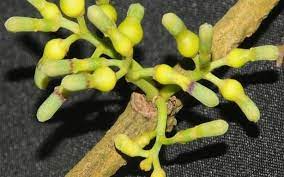Septemeranthus:

A new genus of a parasitic flowering plant has recently been discovered from the Nicobar group of islands.
- The genus Septemeranthus grows on the plant species Horsfieldia glabra (Blume) Warb.
- The parasitic flowering plants have a modified root structure spread on the stem of the tree and are anchored inside the bark of the host tree.
- The plant was found on the periphery of the tropical forest in one of the biodiversity hotspots referred to as the Nicobar group of islands separated from the Andaman group of Islands by a wide gap of 160 km with heavy tidal flows.
- The genus Septemeranthus has a distinct vegetative morphology, inflorescence architecture and floral characters.
- The leaves of the plant are heart-shaped with a very long tip and the ovary, fruit and seeds are ‘urceolate’ (earthen pot-shaped).
- The flowers have five persistent bracts having conspicuous margins.
- The name Septemeranthus is derived from the Latin word ‘septem’ meaning ‘seven’, referring to the arrangement of flowers.
- The genus belongs to the family Loranthaceae, a hemi-parasite under the sandalwood order Santalales and is of widespread importance.
- Plants which are hemi-parasites are partially dependent on their host plants for nutrition. For instance, the newly discovered plant that derives nutrients from its hosts has green leaves capable of photosynthesis.




